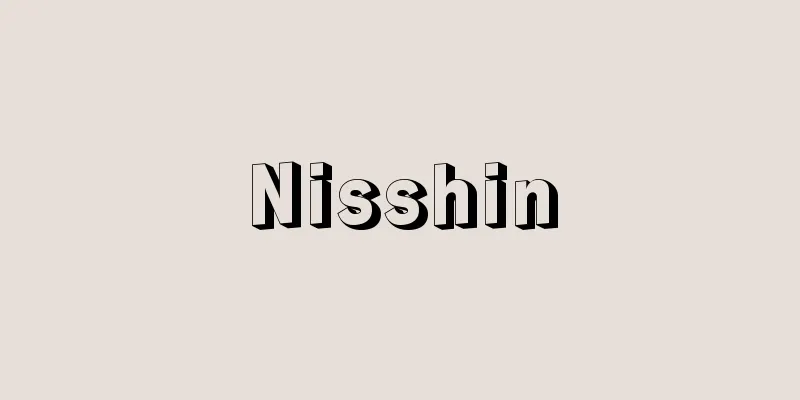Nisshin

|
Year of death: September 17, 1488 (October 21, 1488) Year of birth: 1407 A Nichiren sect monk from the Muromachi period. His name was Kuonjoin. He was from Kazusa Province (Chiba Prefecture). He first studied under Nichiei at Nakayama Hokekyoji Temple. In 1427, he went to Kyoto and began his activities of spreading the teachings. In 1433, he went to Kyushu as the head priest of the Nakayama school and instructed his followers, but he was excommunicated from the school due to opposition to his strict shakubuku ideology. In 1436, he went to Kyoto again and built Honpo-ji Temple, and urged Shogun Ashikaga Yoshinori to uphold the Lotus Sutra faith and reject other sects, but was refused, and he was banned from further evangelism. He disobeyed this order and wrote "Rissho Chikoku Ron" (The Treatise on the Rule of the Nichiren sect), and was preparing to spread the teachings again when his actions were discovered and he was arrested, and he was tortured, including having a bamboo skewer thrust into his penis and the tip of his tongue cut off. It is said that a red-hot iron pot was placed over his head at that time, which later led to him being called "Nabe Kamuri Nisshin" during the Edo period. In 1441, Nisshin was pardoned when Yoshinori was murdered by Akamatsu Mitsusuke, and he rebuilt Honpo-ji Temple, which had been destroyed during the persecution. In 1460, while touring Kyushu, Nisshin's fierce attacks on other sects led to the destruction of Honpo-ji Temple at the request of local monks of various sects. Nisshin was summoned and imprisoned, but was pardoned the following year and rebuilt Honpo-ji Temple for the third time. Nisshin emphasized his position as the orthodox proponent of Buddhist supremacy since Nichiren, and always took a combative stance against other sects, various Nichiren sect branches, and even the powerful people who supported them. His portrait eventually became the object of worship for the common people as a Buddha who wards off disasters and brings good fortune. <References> Nisshin, by Nakao Takashi (Hiroo Sato) Source: Asahi Japanese Historical Biography: Asahi Shimbun Publications Inc. About Asahi Japanese Historical Biography |
|
没年:長享2.9.17(1488.10.21) 生年:応永14(1407) 室町時代の日蓮宗の僧。久遠成院という。上総国(千葉県)の人。はじめ中山法華経寺日英に師事。応永34(1427)年,上洛して弘教活動を開始。永享5(1433)年には中山門流の総導師として九州に赴き門徒を指導するが,その厳しい 折伏主義への反発によって逆に同門流から破門された。同9年,再び上洛して本法寺を建立,将軍足利義教に法華信仰の受持と他宗の排斥を勧めたが拒否され,以後の伝道も禁止される。この命令にそむき『立正治国論』を著して再度の弘教を準備中に露見して逮捕,陰茎に竹串を突き刺されたり舌先を切り取られるなどの拷問を受けた。そのとき赤く焼けた鉄鍋を頭にかぶせられたといわれ,そのことが後世,江戸時代に「なべかむり日親」と呼ばれる原因となった。嘉吉1(1441)年,義教が赤松満祐に殺害されることによって赦免,弾圧中に破壊された本法寺を再建した。寛正1(1460)年,九州巡錫の途中,他宗への激しい攻撃のため,当地の諸宗僧侶の訴えにより本法寺を破却される。日親も召喚され投獄されたが翌年には赦免,三たび本法寺を建立した。日親は日蓮以来の仏法至上主義の正統として自身の立場を強調し,諸宗や日蓮宗各派,さらにはそれを後押しする権力者に対して常に戦闘的な姿勢をとった。その肖像はやがて攘災招福の仏として庶民の信仰の対象となる。<参考文献>中尾尭『日親』 (佐藤弘夫) 出典 朝日日本歴史人物事典:(株)朝日新聞出版朝日日本歴史人物事典について 情報 |
Recommend
Osvát E. (English spelling)
…The name of the magazine means “West.” Until 192...
Itoigawa Matsudaira Family
...Naora was given 50,000 koku in Echizen Ono in ...
Pneumonitis
… [Interstitial pneumonia] It refers to a group o...
Blue Funnel Line [Company] (English name) Blue Funnel Line
Ocean Transport & Trading is a shipping compan...
Kannonzaki Park
(Yokosuka City, Kanagawa Prefecture) A tourist att...
Enrei - Enrei
…A pass in the central part of Nagano Prefecture....
Viral encephalomyelitis - Viral encephalomyelitis
...Since 1968, the number of cases of true Japane...
Essay
[1] 〘noun〙 (essay essai)① A genre of literature. A...
"The History of Famous Places in Kai"
…Also, local schools were established in the 22nd...
Pont-Aven faction - Pont-Aven is
A group of painters led by Gauguin. A translation ...
Anser erythropus (English spelling)
… [Yanagisawa Norio]. … *Some of the terminology ...
Richter, JPF (English spelling) RichterJPF
...German novelist. His real name was Johann Paul...
Oboro Konbu - Oboro Konbu
→Tororo kelp Source : Heibonsha Encyclopedia About...
Chimú (English spelling)
...Chan Chan, a culture centered on the city of T...
Arteriosclerosis - Doumyakukouka (English spelling)
What is the disease? Arteries play an important r...









